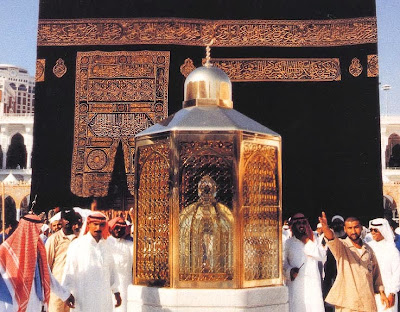 |
| Spotted at the Coop, Safa Park: Ready for Eid al-Adha or Feast of the Sacrifice |
It is a time of
celebration, but also one to think of those less fortunate.
My prayers and
thoughts go to a dear friend who is battling sickness. They are also with those
not celebrating due to illness, war and poverty.
I wrote
extensively about Eid al-Adha in a post two years ago, but here again is
what Hajj and Eid al-Adha is all about for those new to Mich Café and to
the customs of the region.
Literally, Hajj means “to set out for a place."
For Muslims, that place is the Holy City of Mecca, in Saudi Arabia.
Muslims worldwide
celebrate Eid al-Adha
to commemorate the willingness of Abraham (Ibrahim) to sacrifice his son
Ishmael as an act of obedience to God, before God intervened to provide him
with a ram to sacrifice instead. Hence the sacrifice of a lamb, a goat, a cow or a
camel on Eid al-Adha.
The sacrificial meat is divided into three
parts: one-third for the family; another third for relatives, friends and
neighbors; and the remaining third to the poor and needy.
Eid al-Adha is celebrated annually on the 10th day of the
12th and last Muslim month of Dhu al-Hijjah of the lunar Islamic
calendar. Celebrations start after the Hajj, when Muslims descend from Mount
Arafat.
 |
| Pilgrims at Mount Arafat (Photo via Saudi Ministry of Hajj) |
It is professed that when Abraham was ready to
return to Canaan he was to leave behind his wife Hajar and baby son. Hajar
asked him, “Did God order you to leave us here? Or are you leaving us here to
die.” Abraham was so sad he fell silent but pointed to the sky. Hajar said, “Then
God will not waste us; you can go.”
 |
| The Zamzam Well |
Years later, Abraham was instructed by God to
return from Canaan to build a place of worship adjacent to Hajar's well.
Abraham and Ishmael constructed a stone and mortar structure -- known as the Kaaba.
It was to be the gathering place for all who wished to strengthen their faith in
God.
One of the main trials of Abraham's life, at
99, was to fulfill God’s command to devote his dearest possession, his then only
son Ishmael, 13. Upon hearing this command, he prepared to submit to God's
will. During this preparation, Satan tried to dissuade Abraham and his family
from carrying out God's commandment, but they drove Satan away by throwing
pebbles at him. In commemoration of their rejection of Satan, stones are thrown
at symbolic pillars signifying Satan during the Hajj rites.
As a reward for this sacrifice, God then
granted Abraham the good news of the birth of his second son, Isaac: “And We
gave him the good news of Ishaaq, a prophet from among the righteous.”
Muslims commemorate Abraham’s ultimate act of
sacrifice during Eid al-Adha.
Ishmael married
the daughter of the chief of the Banu Jurhum, a tribe that had settled in the
Mecca valley. When Ibrahim died, Ishmael continued to perform Hajj each year
and to look after the Kaaba.
 |
| Pilgrims circumbulating the Kaaba (Saudi Ministry of Hajj) |
Seeing the Kaaba
in a state of disrepair, Qusay bin Kilaab, of the Quraysh tribe, rebuilt it,
according to the original design but adding a roof to protect it from the
extremes of weather. Qusay, born around 400 CE, was renowned for his wisdom.
The starting
point for the circumambulation of the Holy Kaaba is where Abraham placed the
Black Stone in the eastern corner. The Black Stone (al-Hajar al-Aswad) was
brought from Paradise by Archangel Gabriel and was set into one corner of the Kaaba.
In the course of
their Hajj, pilgrims will kiss or
touch the Black Stone because the Prophet Mohammad (PBUH) kissed it. On the
roof of the Kaaba is a gilded waterspout (al-Masabb)
protruding from the northwestern wall.
 |
| The station of Abraham or Maqam Ibrahim (Saudi Ministry of Hajj) |
Nearly
opposite the Black Stone, near the Maqam Ibrahim, is the Zamzam Well.
The Kaaba, is a
large stone structure constituting a single room with a marble floor. It lies
at the heart of the Holy Mosque (al-Masjid al-Haram). It stands some 60
feet high and each side is approximately 60 feet in length. The four walls of
the Kaaba are covered with a black drape that is 45x135 feet -- the Kiswah.
Every year, a new
Kiswah is prepared, embroidered in gold thread with the Shahadah and
verses from Qur'an and carried to Mecca by pilgrims. A recent estimate of
producing the Kiswah each year put the cost at about $4.5 million.
During the Hajj, the black Kiswah is replaced by a white cloth, matching
the white robes of the pilgrims. At the end of Hajj, the newly woven Kiswah
is placed over the Kaaba. The old one is cut into small pieces and given to
pilgrims from different Muslim countries.
I wish all my
readers celebrating the occasion a happy, healthy and blessed Eid al-Adha.
